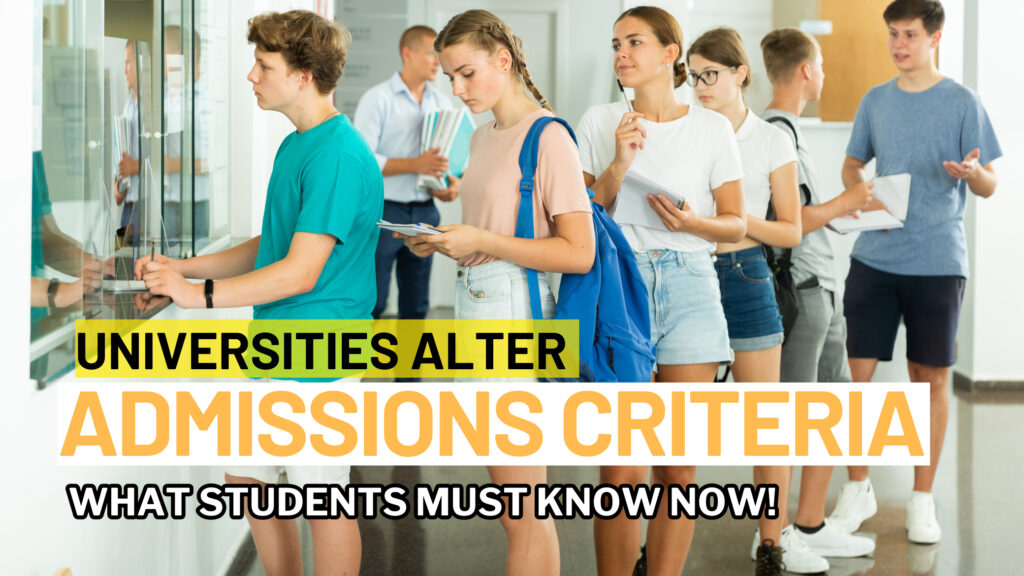Why Some Universities Are Quietly Changing Admissions Criteria
In recent years, I’ve noticed a significant shift in how universities approach their admissions criteria. This change, often happening quietly behind the scenes, reflects broader trends in education and society. So, Why Some Universities Are Quietly Changing Admissions Criteria? As prospective students, understanding this shift can provide valuable insights into the future of higher education.

What Prompted the Change in University Admissions Criteria?
In recent years, a confluence of factors has prompted universities to reevaluate their admissions. One of the primary influences is the growing emphasis on diversity and inclusion within higher education. Institutions are recognizing that a diverse student body enriches the educational experience for everyone and prepares students to thrive in a global society. As a result, many universities are rethinking how they evaluate applicants, moving beyond traditional metrics to include a broader range of qualifications.
Economic disparities have also played a significant role in this shift. The rising awareness of social inequalities has prompted universities to reflect on how their admissions criteria may inadvertently favor certain groups over others. This recognition has led many institutions to assess whether their traditional standards, often heavily reliant on standardized test scores and GPAs, adequately reflect a student’s potential and ability to succeed in college.
As the job market evolves, universities are acknowledging the need to adapt their admissions criteria to better prepare students for a dynamic and unpredictable workforce. Employers increasingly value skills such as critical thinking, creativity, and interpersonal communication, which are not always captured through traditional academic assessments. Universities are beginning to seek out applicants who demonstrate these skills and experiences, recognizing that they are essential for success beyond the classroom.
Role of Social Justice and Equity in Changing Admissions Criteria
Social justice has become a theme in the ongoing conversation about admissions criteria. Many universities are striving to create a more equitable system that genuinely reflects the diverse society we live in. This shift means that admissions committees are now considering not just academic achievements, but also the unique experiences, backgrounds, and perspectives that each student brings to the table.
By expanding the definition of what constitutes merit, universities aim to level the playing field for all applicants. For instance, this approach may include recognizing achievements in community service, leadership roles, and personal resilience. These factors can significantly contribute to a student’s potential for success in higher education.
In this context, admissions criteria are evolving to prioritize a holistic view of applicants, ensuring that a wider array of talents and experiences are valued. This shift reflects a broader commitment to social equity and justice within higher education. As a result, universities are increasingly aware that their admissions practices can either perpetuate or challenge existing inequalities.
By rethinking their admissions criteria, they are taking proactive steps toward fostering a more inclusive academic environment that benefits everyone.
Impact on Prospective Students in Changing Admissions Criteria
For prospective students, these changes can be both exciting and daunting. On one hand, new admissions criteria may open doors for students who previously felt overlooked. On the other hand, the evolving landscape can create confusion about what universities are truly looking for in applicants. It’s essential for students to stay informed and understand how these changes might impact their chances of acceptance.
Tips for Applicants for Changing University Admissions Criteria
Successfully navigating this new admissions landscape requires a strategic approach. Here are some key tips for prospective students:
- Showcase Individual Strengths: Applicants should focus on highlighting their unique strengths and experiences. This can include detailing achievements in community service, leadership roles, or any significant challenges overcome. By sharing these personal narratives, students can provide a fuller picture of who they are and what they can bring to the university.
- Engage in Meaningful Activities: Getting involved in extracurricular activities, volunteer work, or projects that resonate personally can enhance an application. Admissions committees are increasingly interested in candidates who demonstrate a commitment to their communities and who can articulate the impact of their involvement.
- Research Specific Universities: Each university may have its own distinct criteria and values. It’s important for applicants to thoroughly research the institutions they are interested in and understand what they prioritize in their admissions process. Tailoring applications to align with these values can make a significant difference.
- Emphasize Personal Growth: When crafting personal statements or essays, students should reflect on their journey and how their experiences have shaped them. Highlighting moments of personal growth or resilience can resonate with admissions committees looking for well-rounded individuals.
- Seek Guidance: Finally, prospective students should consider seeking advice from teachers, mentors, or counselors. These individuals can provide valuable insights and feedback on application materials, helping students refine their narratives and ensure they are effectively communicating their strengths.
Comparing Traditional vs. New Admissions Standards
Key Differences in Evaluating Applicants
Traditionally, university admissions criteria heavily emphasized standardized test scores and GPAs. These metrics were viewed as primary indicators of a student’s academic capabilities and potential for success in higher education.
Many universities are now shifting away from this narrow focus. They recognize that such admissions criteria do not capture the full spectrum of a student’s abilities or potential contributions to campus life.
As a result, universities are increasingly considering qualitative factors when evaluating applicants. For instance, letters of recommendation provide insights into a student’s character and work ethic, while personal statements allow candidates to express their unique narratives and motivations. Extracurricular activities—such as involvement in clubs, sports, or community service—are gaining importance in the admissions process.
This evolution reflects a growing understanding among educational institutions that academic performance alone is insufficient to define a student’s potential. By broadening the admissions criteria, universities seek to create a more comprehensive evaluation system that acknowledges diverse talents and experiences.
Success Stories Under the New Changing Admissions Criteria
Many students have already benefited from these changes in admissions criteria. Take, for example, a first-generation college student who, despite lower standardized test scores, gained acceptance to a prestigious university due to her remarkable community service and leadership skills. Her story exemplifies how a more inclusive approach can create opportunities for deserving candidates.
Challenges Faced by Applicants in the Transition
Not all students have found the transition easy. Some applicants feel overwhelmed by the new expectations and are unsure how to present themselves effectively. The lack of clarity around admissions criteria can lead to anxiety, as students strive to meet the evolving standards. It’s essential for universities to provide clear guidance to help prospective students navigate these changes.
Expert Insights on Changing Admissions Criteria
Perspectives from Admissions Officers
Admissions officers have valuable insights into the evolving landscape of admissions criteria. Many of them express a strong commitment to finding a balanced approach that considers both academic merit and individual experiences. They emphasize the importance of viewing applicants holistically, understanding that a well-rounded evaluation can lead to a richer and more diverse student body. For instance, admissions officers are increasingly looking beyond traditional metrics, such as test scores and GPAs, to assess qualities like leadership, resilience, and community engagement.
What Educational Leaders Are Saying
Educational leaders strongly echo the sentiments of admissions officers, stressing the need for change in the admissions landscape. They argue that shifting the focus from traditional metrics to a more inclusive evaluation process can benefit not only students but also the universities themselves. By diverse backgrounds and experiences, educational institutions can enhance the learning environment for all students.
Leaders in education advocate for a reimagining of admissions criteria that prioritizes inclusivity and equity. They point out that when universities adopt a more comprehensive view of applicants, they are better equipped to identify individuals who can thrive in their unique academic settings. This not only enriches the educational experience but also prepares students to engage with a diverse society beyond the classroom.
Quiet changes in university admissions criteria are a reflection of larger societal shifts toward equity and inclusion. As prospective students, it’s very essential to understand these developments and adapt to the new landscape. By focusing on what makes each of us unique, we can all play a part in shaping the future of higher education.







